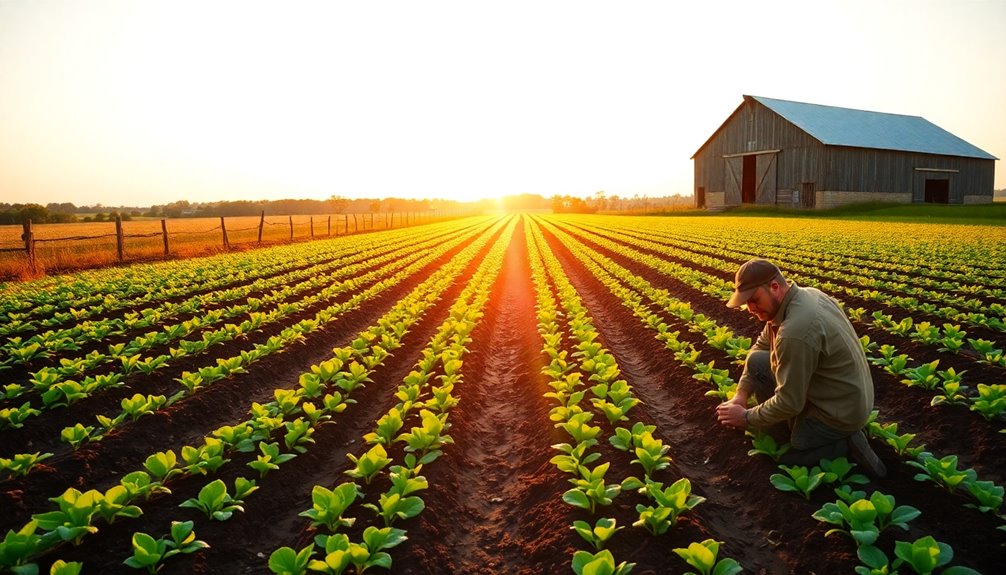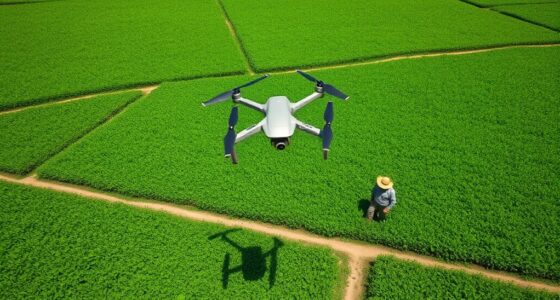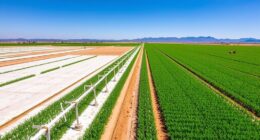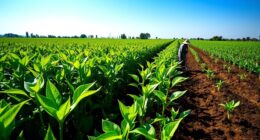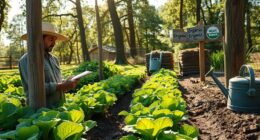Subsistence farming means you grow food mainly for your own use, ensuring you meet your basic dietary needs. This practice promotes self-sufficiency in agriculture, reducing your reliance on external sources. Many smallholder farmers globally depend on subsistence farming for survival, contributing to local economies and food security. You'll often find techniques like crop rotation and intercropping, which help maintain soil health and enhance crop yields. While it faces challenges such as climate change, this form of farming embodies cultural heritage and community bonds. Exploring further reveals the rich benefits and strategies inherent in subsistence farming today.
Key Takeaways
- Subsistence farming focuses on growing food primarily for personal use, ensuring dietary needs are met without reliance on external markets.
- It supports self-sufficiency by reducing dependence on imported foods and enhancing local food security.
- Traditional practices like crop rotation and polyculture improve soil health and biodiversity, fostering sustainable agricultural systems.
- The practice promotes economic stability through local trade and employment, benefiting rural communities and reducing poverty rates.
- Subsistence farming preserves cultural heritage, empowering communities and strengthening social bonds through shared agricultural knowledge and practices.
Understanding Subsistence Farming
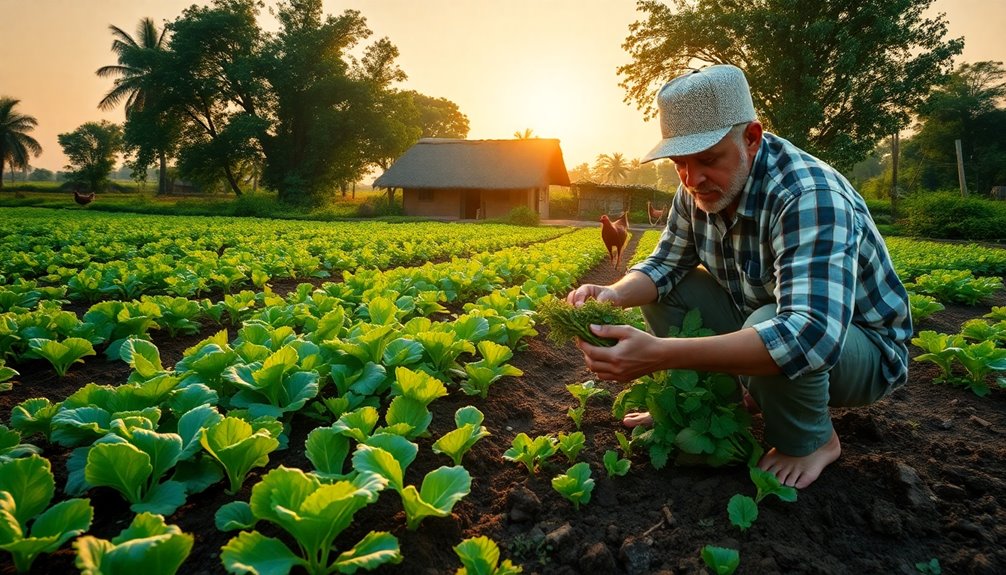
Subsistence farming is all about growing food primarily for personal use, ensuring that farming families can meet their own dietary needs. This practice is essential for food security, especially in developing regions where nearly 2 billion people rely on it.
Smallholder farmers often utilize techniques like crop rotation and intercropping to maintain soil health and adapt to changing environmental conditions exacerbated by climate change. These traditional farming methods not only support individual households but also help preserve cultural heritage within rural communities.
However, subsistence farmers face challenges such as limited access to modern technologies and inadequate market access, which can threaten their economic stability and the food security of their families. Embracing these practices is key to resilience in agriculture.
Historical Overview
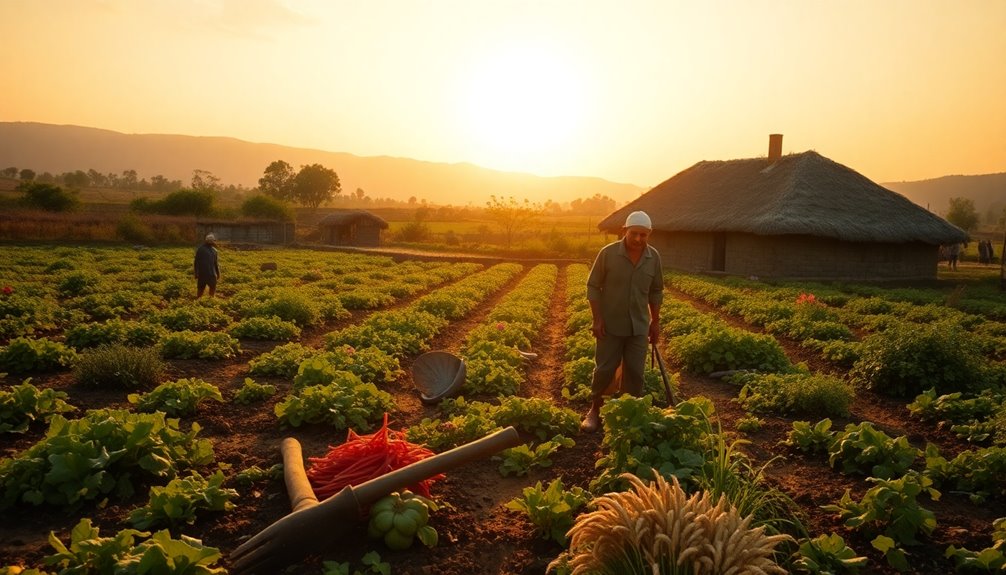
Farming practices have evolved markedly over time, shaped by various social and economic factors.
Subsistence farming began with early agricultural societies, focusing on producing food mainly for local consumption. As urbanization progressed, market-oriented agriculture emerged, leading to a decline in traditional practices.
Historically, farmers practiced shifting agriculture, relocating as soil fertility diminished, but this changed with the establishment of more permanent farming systems. By the early 20th century, subsistence agriculture largely vanished in Europe due to urban growth and the rise of commercial farming.
In North America, the decline occurred during the 1930s and 1940s. More recently, semi-subsistence agriculture saw a brief resurgence in Central and Eastern Europe post-1990, but its decline resumed with EU accession, reflecting broader economic changes.
Types of Subsistence Farming

When you explore the types of subsistence farming, you'll encounter shifting agriculture, intensive subsistence techniques, and the nomadic herding lifestyle.
Each method reflects unique adaptations to the environment and local resources, shaping how communities meet their needs.
Understanding these practices can give you insight into the diverse ways people sustain themselves around the world.
Shifting Agriculture Practices
In many rural communities, shifting agriculture practices, commonly known as slash-and-burn farming, play an essential role in food production.
As a subsistence farmer, you clear forest land by cutting and burning vegetation to cultivate crops like rice, maize, and cassava for 2-3 years. This method relies on the soil fertility, allowing you to grow diverse crops before moving to a new plot for recovery.
By integrating traditional knowledge about local ecosystems, you promote biodiversity, ensuring various species thrive in your fields.
While shifting agriculture can be sustainable at low population densities, be cautious, as higher pressures may lead to deforestation and soil erosion.
Embracing sustainable practices is key to maintaining the health of your land and community.
Intensive Subsistence Techniques
Intensive subsistence techniques focus on maximizing crop yields from small plots of land, especially in densely populated regions. By employing intensive agriculture practices, you can achieve higher outputs through high labor input and multiple annual crop cycles.
Farmers often use methods like terracing and artificial irrigation to enhance productivity. Additionally, practicing polyculture allows you to grow various crops together, boosting biodiversity and minimizing risks from pests and diseases.
This approach not only supports sustainable agriculture principles but also promotes soil health and resource conservation. Smallholders in countries like India and China rely on these techniques to sustain their families and contribute to local markets, demonstrating the essential role of intensive subsistence farming in food security.
Nomadic Herding Lifestyle
Nomadic herding represents a unique subsistence farming lifestyle where pastoralists migrate with their livestock to find pasture and water. This practice, common in regions like central Asia and northern Africa, relies on a keen understanding of climate conditions and local ecosystems. Key livestock, such as cattle and camels, serve as crucial food sources and support community resilience.
| Traditional Practices | Challenges |
|---|---|
| Seasonal migration | Climate change impacts |
| Knowledge sharing | Land degradation |
| Cultural identity | Policy restrictions |
Through these traditional practices, nomadic herders maintain their livelihoods while adapting to environmental changes. However, threats to sustainability challenge the future of this essential rural agriculture lifestyle.
Techniques and Practices
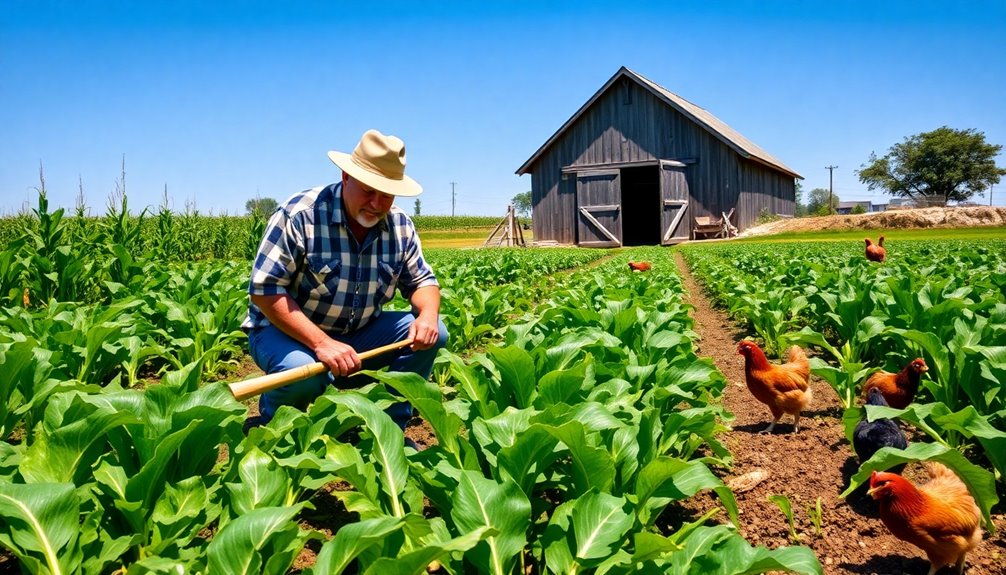
Subsistence farming employs various techniques and practices that enhance productivity while ensuring sustainability. One effective method is crop rotation, which maintains soil fertility and reduces pest infestations by alternating different crops.
You might also consider polyculture, where you cultivate multiple crops together, boosting biodiversity and providing a balanced diet while lowering the risk of total crop failure.
Traditional methods like contour plowing and terracing help conserve soil and water, especially in hilly areas, promoting agricultural sustainability.
Additionally, integrating agroforestry systems with trees and shrubs supports soil health and shade.
Finally, employing rainwater harvesting techniques captures and stores rain, ensuring a reliable water source for irrigation, ultimately enhancing food security in your subsistence farming efforts.
Economic Benefits

When you think about subsistence farming, consider how it boosts food security and local economies.
By focusing on sustainable resource management, it not only helps families thrive but also strengthens the community.
This practice creates a resilient economic foundation, ensuring that people can support themselves and each other.
Food Security Enhancement
Food security is greatly enhanced through the practice of subsistence farming, as it allows families to cultivate their own crops, reducing reliance on external supply chains.
This method supports smallholder farmers, providing them with a pathway to self-sufficiency and improved rural livelihoods. By growing diverse crops, you promote agricultural biodiversity, ensuring access to essential nutrients while also stabilizing food supplies during economic downturns.
Subsistence farming plays a vital role in poverty alleviation, with evidence showing a direct link between these practices and reduced poverty rates.
In regions like sub-Saharan Africa, where a considerable percentage of the population relies on subsistence agriculture, the increased crop yields contribute notably to national GDP and enhance overall food security for communities.
Local Economic Stability
Local economies thrive on the foundation that subsistence farming provides. By prioritizing local resources, this practice fosters self-reliance and food security while bolstering community resilience in rural areas.
Here are three key economic benefits of subsistence farming:
- Reduced Dependence on Imports: Families rely on their own produce, minimizing the need for imported goods.
- Poverty Reduction: Evidence shows a direct link between subsistence farming and reduced poverty rates, enhancing income stability.
- Local Trade Promotion: Barter systems flourish as families exchange goods, strengthening local economic networks.
In regions like sub-Saharan Africa, subsistence agriculture considerably contributes to local economic stability, employing a large portion of the population and supporting essential livelihoods.
Sustainable Resource Management
Sustainable resource management is a cornerstone of subsistence farming, benefiting both the environment and local economies. By engaging in sustainable management practices, you can enhance biodiversity and improve soil health, leading to better crop yields.
This approach not only supports self-sufficiency for smallholder farmers but also fosters economic stability in rural areas. With approximately 2 billion people relying on subsistence farming globally, integrating agroecological principles becomes essential.
These practices help reduce household vulnerability to market fluctuations, ensuring consistent access to essential nutrition. In Sub-Saharan Africa, for instance, subsistence agriculture notably contributes to national GDP and employs a large portion of the population.
Ultimately, this sustainable model promotes long-term agricultural productivity and resilience, benefiting both farmers and their communities.
Environmental Challenges
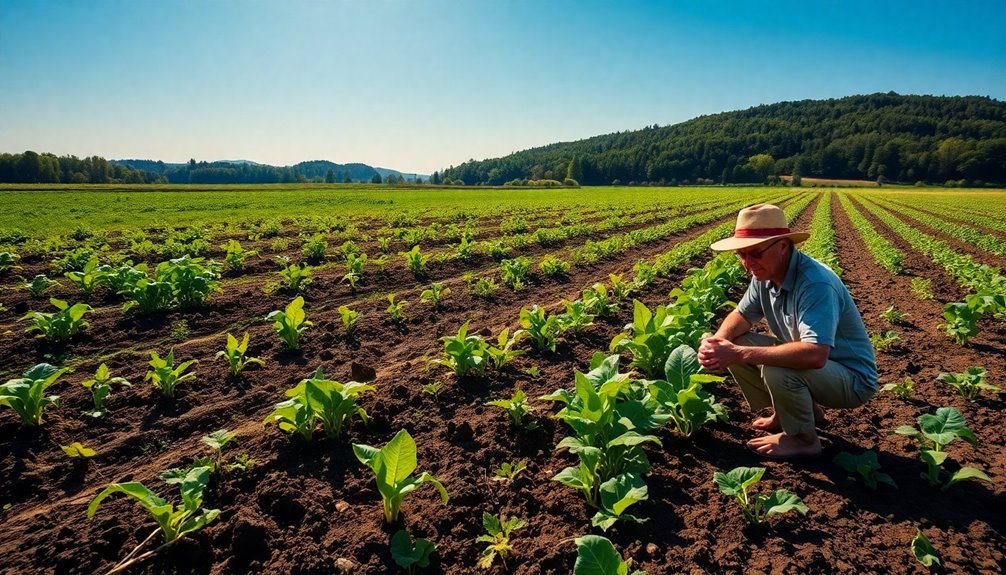
Environmental challenges pose considerable threats to subsistence farming, often throwing farmers into a cycle of uncertainty. Subsistence farmers often face the harsh realities of climate change, leading to decreased crop yields and jeopardizing food security.
Key issues include:
- Soil Degradation: Traditional farming practices can worsen soil quality, reducing land productivity and exacerbating food insecurity.
- Water Scarcity: Limited water resources considerably impact crop growth and livestock health, threatening livelihoods.
- Environmental Factors: Extreme weather events and pest invasions can lead to severe crop losses, making farmers vulnerable to economic instability.
These challenges create a precarious situation for subsistence farmers, hindering their ability to maintain sustainable agricultural practices and secure their families' futures.
Adaptation Strategies
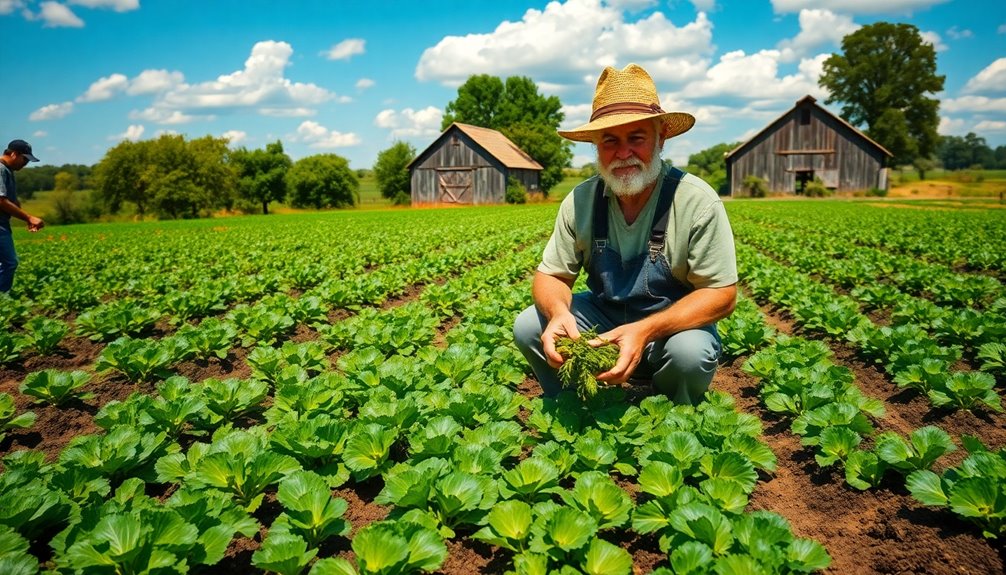
Subsistence farmers' resilience in the face of climate challenges is evident through their innovative adaptation strategies. They often implement practices like crop rotation and intercropping, which enhance soil health and provide better resilience against extreme weather conditions.
By leveraging indigenous knowledge, you can select heat-tolerant crop varieties that withstand rising temperatures while maintaining yields. Many engage in agroecological practices, promoting biodiversity and ecosystem services, further aiding adaptation to environmental stressors.
To combat water scarcity, farmers adopt rainwater harvesting techniques, ensuring a reliable water supply during dry spells. Additionally, community-based initiatives, such as farmer cooperatives, foster knowledge sharing and resource access, greatly enhancing the adaptive capacity of subsistence farming communities, allowing you to thrive despite climate change. Furthermore, incorporating practices like crop diversification can help mitigate the risks associated with climate variability and improve overall food security.
Cultural Significance
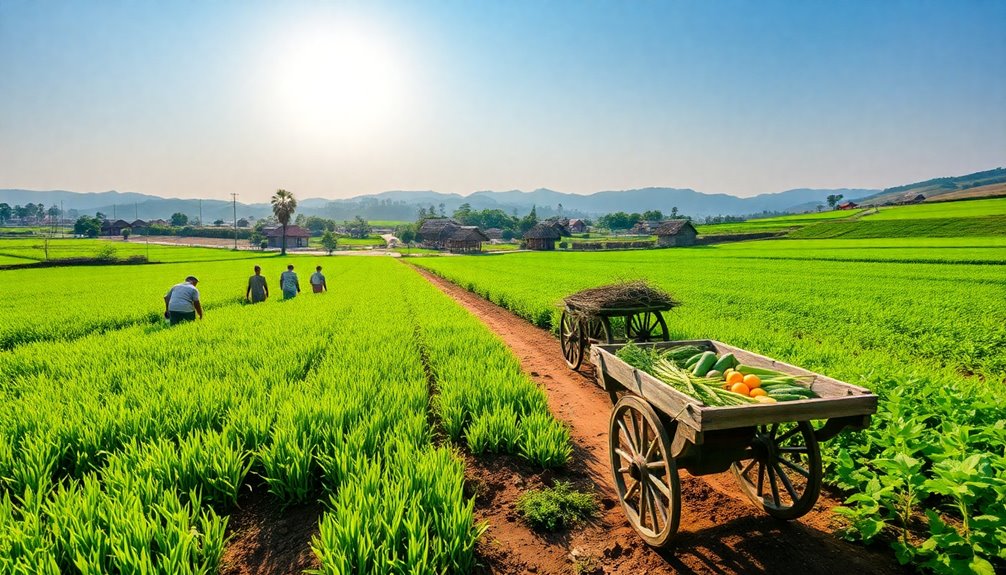
At the heart of rural communities lies a rich tapestry of cultural significance tied to farming practices. Subsistence farming isn't just about growing food; it embodies cultural heritage and preserves generations of agricultural knowledge. This practice promotes biodiversity, which is essential for ecological balance.
Here are three key aspects of its cultural significance:
- Community Bonds: Communal planting and harvesting activities strengthen relationships among farmers, fostering a tight-knit community.
- Food Sovereignty: By prioritizing self-sufficiency, subsistence farming empowers communities to control their food sources.
- Harvest Festivals: Celebrations surrounding agricultural cycles, like harvest festivals, enhance cultural identity and communal ties.
Through these elements, subsistence farming plays a crucial role in maintaining the unique cultural fabric of rural life.
Frequently Asked Questions
What Is the Meaning of Subsistence Farming?
Subsistence farming means you're growing enough food to feed yourself and your family, rather than for selling in markets.
You typically rely on small plots of land and traditional methods, like crop rotation and intercropping, to sustain your household.
While it mightn't yield much surplus, this practice helps you achieve self-sufficiency and resilience against economic challenges.
Many people around the world depend on subsistence farming to meet their daily dietary needs.
What Does It Mean to Be Agriculture Self Sufficient?
Being agriculturally self-sufficient means you can grow enough food to meet your own needs without relying on outside sources. It allows you to control your food supply, reduce costs, and enhance resilience against market fluctuations.
You implement practices like crop rotation and polyculture, which boost productivity and maintain soil health. By achieving this self-sufficiency, you not only secure your household's food but also support local economies and contribute to overall food security.
Is Subsistence Agriculture Good or Bad?
Did you know about 2 billion people globally practice subsistence agriculture? This approach has its pros and cons.
On one hand, it promotes self-sufficiency and food security, helping families thrive without relying on external markets.
On the flip side, it can limit income potential and access to modern technology, which can hinder growth.
Ultimately, whether subsistence agriculture is good or bad depends on individual circumstances and the balance between sustainability and economic opportunity.
What Is Subsistence Agriculture and Why Does It Often Result in Poverty?
Subsistence agriculture focuses on growing enough food for you and your family's needs, leaving little for sale. This often leads to poverty because you're limited in income and resources.
Without access to modern farming techniques, your productivity stays low, making it hard to break the cycle of financial struggle.
Additionally, unpredictable weather can threaten your crop yields, further jeopardizing your food security and economic stability in the long run.
Conclusion
In exploring subsistence farming, you've likely realized how intertwined it is with self-sufficiency and sustainability. It's fascinating how these age-old practices echo in today's world, as more people seek to reconnect with their food sources. You might even see parallels in your own life—perhaps growing a small garden or supporting local farmers. Just like those who depend on the land, you can cultivate your own path to resilience. It's a journey of discovery, one plant at a time.

